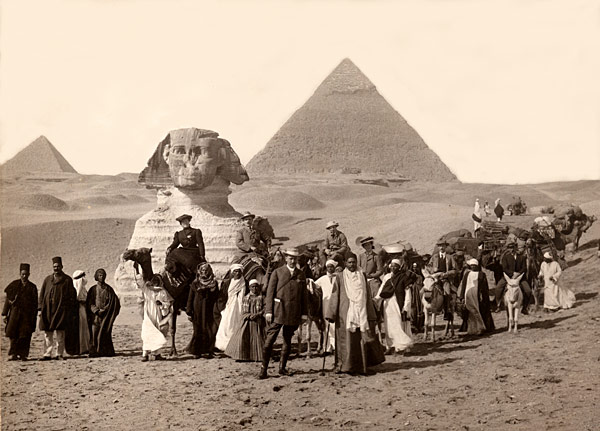|

1907 Oligocene of Egypt
The expedition was under the leadership of Prof. Henry F. Osborn, with Walter Granger and George Olsen as assistants.
Mr. Richard Markgraf, an independent collector residing in Cairo was employed for 6 weeks, working separately in his own camp.
Mr. Hartley T. Ferrar of the Survey Department field staff accompanied the party to the Fayum and remained for 2 weeks.
Twenty Fallaheen workmen, under the superintendance of Daoud Mohammed of Helouan, were employed.
Shiekh Talba with 5 or 6 fellaheen conducted the camel train.
The Survey Department placed its services at the disposal of the party, loaning tents, water tanks, tools, cooking outfits, etc., and arranging for the employment of locals and camels. Twelve camels were hired and ordered to proceed to Tamia in the Fayum, the nearest railway point to the fossil fields.
Granger and Olsen accompanied Prof. Osborn's personal caravan, leaving Mena House on Jan. 31st, traveling southward through the Pyramid field and entering the Fayum from the Lisht Pyramid on Feb. 3rd.
Two days later, Feb. 5th, the caravan came to the Easterly Bone Pits, north of Birket-el-Qurun where a permanent working camp had been established.
The following day work began in one of these pits, termed Quarry A, with 7 workers. On the 8th 12 workers arrived from Sakkarah.
They had been employed by Mr. Quibell at an excavation. A second quarry, Quarry B was reopened under Mr. Olsen's superintendance. These bone pits were discovered and worked by Mr. Beadnell and later worked by Dr. Andrews from the British Museum of Natural History.
Except for short periods these pits were worked continuously by the party from the time of its arrival until late in April. A small bone pit about 2 miles west of camp, called Quarry C was worked by Mr. Granger and a force of 5 men for several days in the middle of the month, and several other minor pits, scattered over the fossil field, were reopened and worked sufficiently to show that they were exhausted.
On Feb. 8th Prof. Osborn with his personal party and Mr. Ferrar departed from the desert, and returned to Cairo, leaving Mr. Granger in charge.
Mr. Richard Markgraf, who had prospected in the neighborhood independently, was employed at this time through arrangements of Prof. Osborn. The material already collected was turned over to the AMNH, and he continued to prospect until Mar. 31st, working in his own camp and covering the area from the Easterly Bone Pits to the Alexandria Trail. Early in April with the quarries pretty well worked out most of the Quft men left. The 2 remaining Quft men and the 2 from Tamia, together with Reis Daoud and the cook remained with the outfit until camp was broken late in April.
On April 21st camp was moved from the bone pits to Quasr-el-Sagna where a stay of 3 or 4 days was made to prospect the Middle Eocene exposures there.
On April 24th Tamia was reached. While in Tamia waiting for a train, a cablegram was received from Prof. Osborn instructing the party to remain in the desert for further work. Prof. Osborn desired an Asinotherium skeleton for exhibit back in New York, and the expedition had failed to turn up with a good example of this Rhino-like double horned mammal.
Granger returned to Cairo to repair tents and get hot weather clothing, before returning to the desert, as the summer months in the Sahra can be incredible hot.
Six camels were engaged for the 2nd trip. Daoud and the cook were retained, as well as the 2 men from Tamia, who were especially good workmen.
The first camp was made at Quasr-el-Sagha.
A few days later the party moved just above the temple and the Upper Eocene bench where the eastern extension of the fossiliferous area was examined.
Later a camp was made at the old bone pits, and from there the party moved westward to the Alexandria trail, about the western limit of the fossil area.
May 23rd after several days in this camp, during which time the Moeriherium quarry was examined, the return eastward was begun, stopping for 5 days at Ferrar Butte.
Quasr-el-Sagna was the next stopping place, 1 day. and on May 30th Tamia was reached, Granger and Olsen returned to Cairo on May 30th and the fossils were repacked by Olsen.
Although some prospecting was done and a few specimens collected in the Middle Eocene (Qasr-el Sagha) beds, by far the greater part of the time was spent on the Upper Eocene or Fluvio-marine beds, which contained a richer fauna.
Bones were found isolated or in "quarries" or "pits" , where thousands of separate elements are sometimes found in small areas, having apparently been brought together by water action.
Most of the collection came from such quarries, although in every case the finer skulls were found as isolated specimens, the action that brought the quarry bones together serving to break up the skulls.
The preservation of the bone is poor, which is odd, as the wood found associated is thoroughly silicified. The bones are unusually uncrushed and exposure of the bone to air for several weeks or months tended to harden them. 27 cases containing fossils were shipped from Cairo. 500 field numbers were assigned, of which 25 were reptiles.
|